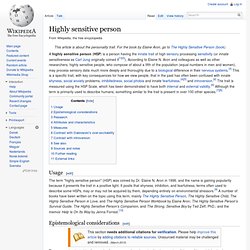

Top 10 Survival Tips for the Highly Sensitive Person (HSP) Highly Sensitive Persons - High Sensitivity and Creative Ability. Susan Meindl Susan Meindl, MA, is a licensed psychologist in private practice in Montreal Canada.

She has a special interest in Jungian ideas and practices a Jungian approach to psychodynamic psychotherapy. Website View all articles by Susan Meindl Sensitivity to Stimulation: A temperamental connection has been observed between between high Sensitivity and creativity. Individuals may manifest extreme sensitivity to stimulation, or psychic over-excitabilities, in any of five areas: intellectual, psychomotor, imaginational, emotional, or sensual. Individuals who have an innate tendency to experience and express themselves in certain combinations of these areas have the potential for a higher level of development. Out of the five, the following three: emotional, intellectual, and imaginational have been theorized to be most indicative of developmental potential and creative expression.
Sometimes over-excitability can cause difficulties... Intensity ! Article Source: About The Highly Sensitive Person. Visceral hypersensitivity in irritab... [J Gastroenterol Hepatol. 2011. Podcast Transcription - Gastrointestinal Disease: Visceral Hypersensitivity. New insights into visceral hyp... [Nat Rev Gastroenterol Hepatol. 2011. Visceral hypersensitivity: facts, speculations, and challenges. Dr M Camilleri, Mayo Clinic, GI Unit, Charlton 7-154, 200 First St SW, Rochester, MN 55905, USA.camilleri.michael@mayo.edu + Author Affiliations Dr M Camilleri, Mayo Clinic, GI Unit, Charlton 7-154, 200 First St SW, Rochester, MN 55905, USA.camilleri.michael@mayo.edu Visceral hypersensitivity is currently the holy grail....it is widely regarded as the reason for the development of functional gastrointestinal diseases, including functional dyspepsia and irritable bowel syndrome.1 Although the field has advanced considerably in the past decade, it is necessary to take stock and realistically appraise our current understanding.

Identifying issues of controversy will help address the directions or priorities to advance this field in the future. Neuroanatomy and physiology of sensation Figure 1 The second order neurone projects from the dorsal horn of the spinal cord to the thalamus and reticular formation in the brain stem (fig 1). Definitions of visceral sensation parameters Figure 2 Figure 3. Sense and Sensitivity. Settling into a chair for coffee with a friend, Jodi Fedor feels her heart begin to pound. Tension creeps through her rib cage. Anger vibrates in her solar plexus. But she's not upset about anything. The person across from her is. Fedor soaks up others' moods like a sponge. On a walk through her neighborhood in Ottawa, Canada, her attention zeroes in on the one budded leaf that hasn't unfurled; it brings a lump to her throat.
Less lovely stimuli can have equally powerful effects. Fedor is sensitive—an adjective usually preceded by too. The Highly Sensitive Person has always been part of the human landscape. Today, science is validating a group of people whose sensitivity surfaces in many domains of life. We all experience shades of sensitivity. Dan Nainan, a full-time stand-up comic based in New York, gets tunnel vision after every show: "A thousand people stop by and say they enjoyed it, but one person says something negative and I take it so personally," he says.
The Highly Sensitive Person: An Interview with Elaine Aron. S0954579410000611jra 7..28 - Ellis_2011.pdf. ClinicalImplica-Aron-p11-44.qxd - JungV8N2p11-44.pdf. Differential susceptibility hypothesis. According to the differential susceptibility hypothesis by Belsky[1] individuals vary in the degree they are affected by experiences or qualities of the environment they are exposed to.

Some individuals are more susceptible to such influences than others––not only to negative but also to positive ones. Differential susceptibility versus diathesis-stress[edit] The idea that individuals vary in their responsivity to qualities of the environment is generally framed in diathesis-stress[2] or dual-risk terms.[3] That is, some individuals, due to their biological, temperamental and/or behavioral characteristics (i.e., “diathesis” or “risk 1”), are more vulnerable to the adverse effects of negative experiences (i.e., “stress” or “risk 2”), whereas others are relatively resilient with respect to them (see Figure 1, an adaptation of Bakermans-Kranenburg and van IJzendoorn’s (2007) Figure 1).
Figure 1. Graphical display of the diathesis-stress/dual-risk model. Highly sensitive person. Usage[edit] Epistemological considerations[edit] The approach adopted by Aron and colleagues questions the role of notions such as "shyness" in explaining basic differences in behavior that are encountered in many species, including humans.

As opposed to shyness, which is best thought of a learned fear of social judgment, but often confused with an innate trait that would have no evolutionary advantage if it were nothing but fearfulness, the trait of high sensitivity is considered a basic, evolutionarily conserved trait with survival advantages in itself. Aron was partly drawn to this conclusion by the early work on normal infant temperament variations,[11] including low sensory threshold, and a shy-bold continuum described in animal species. [12] [13] In both cases, the trait is normal and advantageous in enough circumstances for it to persist. Further, certainly infants with this and other innate traits do grow up and continue to be influenced by their innate temperaments.